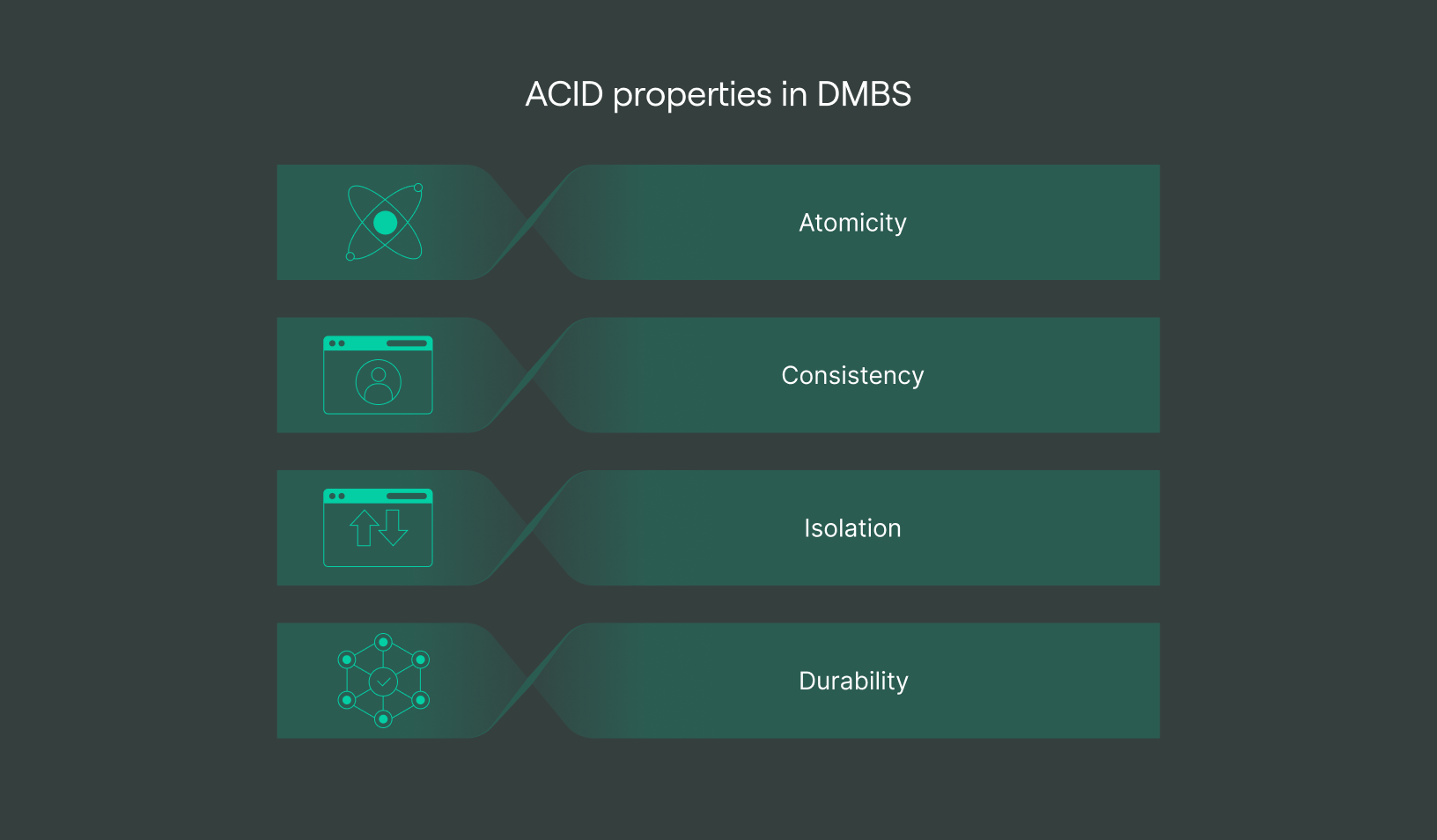
Unlocking the power of database management systems
A Database Management System (DBMS) is an essential computerized data keeping system for efficiently storing, manipulating, and managing burgeoning data volumes. Tailored to support data analysis and augment data-driven processes, these systems address the escalating pace of data generation, ensuring businesses can efficiently manage vast amounts of information while optimizing system resources.
A DBMS’s strength lies in its ability to enhance application performance, fortify data security, and mitigate compliance risks, thereby acting as the backbone of modern data architecture. Employing diverse data models and structures, and offering the ability to access data and manipulate it within federated database systems, DBMSs offer a comprehensive solution for managing databases effectively, unlocking new dimensions of data utility and governance.
Dive into the following article to explore how leveraging the power of a DBMS can transform your data management strategy and catalyze your organization’s growth.
What is a database management system (DBMS)?

In this article, we’ll talk about:
- What is a database management system (DBMS)?
- Key features of a DBMS
- Understanding DBMS types and data models
- Database languages
- ACID properties in a DBMS
- DBMS examples
- Paradigm shift from file systems to DBMSs
- Advantages and disadvantages of a DBMS
- Applications of a DBMS
- Importance of data management
- Best database management tools
- Takeaway
A DBMS is a sophisticated software mechanism that controls and manages databases. This system empowers users to store, modify, and delete data effectively, facilitating data management across diverse scales. Initially, DBMS technology was focused on managing discrete pieces of data. The key elements of a DBMS are the following:
-
The physical database (represents the actual repository for data)
-
Data security (various features that protect data from unauthorized access and breaches)
-
Data integrity (refers to the accuracy and consistency of data over its lifecycle)
-
Backup and recovery (mechanisms to create backups of the database and restore data in case of failures)
As a part of their database architecture, DBMSs often support federated databases, making it possible to integrate multiple disparate databases into a single, unified system. This combination enhances the accessibility and management of the same data across different component systems.
A DBMS can implement various database models to organize data effectively, facilitating efficient data retrieval and manipulation. The application of object-oriented programming principles, for example, is characteristic of object-oriented DBMSs. However, it’s important to note that the use of such principles depends on the type of DBMS, which are many, including relational, object-oriented, hierarchical, and others, each employing different strategies and structures for data management.
Transitioning from traditional file systems to DBMSs significantly improves system resource management and reduces poor application performance. A file system’s limitations in data manipulation and storage capacity can be overcome by a DBMS’s ability to store, access, and delete data efficiently.
Key features of a DBMS
Most database management systems are flexible, thanks to their comprehensive features, catering to the intricate needs of business operations, including sectors like finance and beyond. The core attributes of a DBMS include:
1. Data modeling: It uses either a relational model or object-oriented programming to mirror the complex relationships and structures of data, enabling more intuitive information organization.
2. Storage and retrieval: Surpassing traditional file system limitations, it offers sophisticated methods to store and fetch data, enhancing efficiency and accessibility.
3. Concurrency control: Such a system implements mechanisms that allow simultaneous data access via multiple independent processes. This way, data integrity is not compromised, and system performance remains optimal.
4. Data integrity and security: Employs rigorous protocols to protect financial and other types of data from unauthorized access and corruption, which is crucial for maintaining the sanctity of delete and store data operations.
5. Backup and recovery: Essential for mitigating data loss, these systems enable organizations to recover to a stable state post-disruption.
There are two main types of DBMS: Relational DBMS (RDBMS) and Non-Relational DBMS (NoSQL).

-
RDBMS uses a structured approach with a federated schema to organize and interconnect data, which is ideal for traditional business applications.
-
NoSQL provides a versatile framework for varied data types and storage models (e.g., key-value, document, and graph databases), supporting scalability and flexibility for modern, large-scale applications.
Understanding DBMS types and data models
Database management systems (DBMSs) use different types and data models, each crafted to improve the organization and management of business data. Within these DBMS frameworks, a range of data models are employed, from hierarchical and relational to object-oriented and semi-structured models. These models address wide-ranging data management requirements, with tools like SQL Server utilizing data control and manipulation, concurrent access, and definition languages to retrieve data, plus navigate and manage data elements effectively.
DBMS architectures
The architecture of a DBMS is fundamental to how actual data is organized, safeguarded, and made accessible. Here are the definitions of various types of systems:
1. Centralized systems consolidate stored data in a single location, simplifying database management.
2. Distributed systems enhance data availability and fault tolerance by spreading data across multiple locations.
3. Federated systems offer a unified view of disparate databases, ensuring data integrity without altering the underlying structure.
4. Blockchain systems prioritize data security through a decentralized database management system, especially for transaction data.
5. Cloud systems leverage the cloud as a computerized data-keeping system to provide flexible data storage and easy retrieval for multiple users.
6. Client-server systems operate on a model where multiple client applications request services from centralized server applications, with the server managing database access and operations.
DBMS data models
DBMS Data Models provide a foundation for organizing, accessing, and managing data within a database system. Let’s take a look at some of the common models:
-
A hierarchical database structures data in a tree-like format, allowing for straightforward parent-child relationships.
-
A relational model organizes data into tables, making data access efficient through database schemas.
-
An object-oriented model combines data and processing methods, encapsulating both in objects.
-
An object-relational model integrates features from both the object-oriented and relational models, facilitating the storage and management of more complex data types.
-
A network model offers a flexible graph structure for representing complex relationships.
-
A flat data model presents data in a simple, tabular form, which is ideal for straightforward data storage.
-
A semi-structured model adapts to unstructured data and does not require a rigid schema.
Database languages
Effectively managing and operating a database involves mastery over four principal languages. These include:
1. Data Definition Language (DDL): This is the foundation of the database, shaping its overall structure. It uses commands like CREATE to build new structures, ALTER to modify existing ones, and DROP to remove them. Essentially, DDL sets up the playground where all data activities occur.
2. Data Manipulation Language (DML): DML allows for the addition, modification, and retrieval of data within the database. Commands such as SELECT, INSERT, and UPDATE are part of this language, enabling direct engagement with the data.
3. Data Control Language (DCL): This language is all about access. It defines who gets to see or manipulate the data by managing permissions through commands like GRANT and REVOKE.
4. Transaction Control Language (TCL): TCL keeps transactions in check, ensuring they’re completed successfully, or rolled back if not. It helps maintain the integrity and consistency of the data within the database.
ACID properties in a DBMS

The foundation of integrity and consistency in database transactions is ensured by the ACID principles, which are:
-
Atomicity
-
Consistency
-
Isolation
-
Durability
1. Atomicity
This emphasizes an all-or-nothing approach to transactions within a database environment, ensuring that a transaction is either fully completed, or not executed at all, in order to avoid partial updates and maintain data uniformity.
For example, when executing financial transactions, atomicity allows for the complete success or rollback of fund transfers between accounts. In this part, there are only two actions:
-
Commit: When a transaction is successfully completed, any modifications become visible, embodying the principle of atomicity.
-
Abort: When a transaction is unsuccessful, any changes it attempts to make in the database remain invisible.
2. Consistency
According to this principle, transactions must transform the database from one correct state to another, observing all established rules and constraints. This guarantees the database’s accuracy and dependability, safeguarding data integrity throughout all transactional changes.
3. Isolation
This principle deals with the complexity of concurrent transactions, ensuring they do not interfere with each other. It enables simultaneous data transactions while ensuring they remain independent, thus preventing anomalies and preserving data integrity.
4. Durability
This principle ensures that systems can withstand failures, power outages, or any other disruptions once a transaction is confirmed. It affirms that completed transactions are indelibly recorded in the database, ensuring data permanence. In the event of data loss, a recovery manager will ensure the database’s durability.
Adhering to the ACID properties enables DBMS to effectively oversee data handling, which is essential for intricate data management tasks and expansive integration efforts.
DBMS examples
Here is an overview of renowned DBMS software programs, tailored to meet a variety of needs, ranging from small-scale applications to the demands of large corporations, and accommodating both relational and NoSQL data models:
1. Microsoft Access
Geared towards small and medium-sized initiatives, Microsoft Access provides a relational DBMS with an intuitive graphical interface, simplifying the creation and management of databases without requiring extensive technical knowledge.
2. MySQL
Renowned for its open-source, relational structure and client-server architecture, MySQL is a favorite for web-based applications, offering efficient management of extensive business data.
3. ClickHouse
ClickHouse is an open-source column-oriented DBMS optimized for online analytical processing (OLAP). It offers rapid query execution and efficient data compression and, therefore, is widely utilized in big data ecosystems.
4. Oracle Database
Targeted at larger enterprises, Oracle Database delivers a robust relational DBMS capable of handling complex, sensitive, and hierarchical data structures. It emphasizes security and comprehensive data management.
5. MongoDB
As a leader in the NoSQL category, MongoDB is celebrated for its document-oriented storage, providing flexibility in schema design, which is particularly beneficial for projects with rapidly evolving data requirements.
6. IBM Db2 DBMS
IBM Db2 is a hybrid DBMS optimized for real-time analytics and transactions requiring minimal latency. It serves businesses that prioritize quick data processing and insights.
7. Amazon RDS
Amazon Relational Database Service (RDS) delivers a cloud-driven approach that streamlines database configuration, management, and expansion. It serves up a managed SQL database service, enabling developers to focus more on crafting their applications without the complexities of database administration.
8. PostgreSQL
PostgreSQL, an open-source object-relational database management system, stands out for its robustness, comprehensive adherence to SQL standards, and capability to handle complex data types. This makes it ideally suited for applications demanding rigorous data integrity verification.
9. Apache Cassandra
Apache Cassandra excels in scalability and fault tolerance as a distributed NoSQL DBMS suited for applications that demand reliable performance across extensive, distributed networks.
Paradigm shift from file systems to DBMSs
The transition from traditional file systems to Database Management Systems (DBMS) represents a significant evolution in managing and storing data. File systems often come with challenges; for example:
-
Managing data redundancy and consistency leads to errors and lack of clarity across teams.
-
Accessing data is difficult, especially with rapid data growth.
-
Systems are vulnerable to unauthorized access, compromising data security.
-
There’s no concurrency control, resulting in conflicts during simultaneous access.
-
There are no robust backup or recovery mechanisms, risking data loss.
As an example, let’s consider a university management system relying on a file system. It might face issues like duplicate student records, updating course details across all files, or difficulties providing real-time access to grades.
Switching to a DBMS addresses these issues by ensuring all the data is centralized, enforcing uniform data administration procedures, and leveraging SQL Server’s data control and manipulation languages for secure, efficient access and management.
Advantages and disadvantages of a DBMS
Adopting a Database Management System (DBMS) brings numerous benefits, streamlining how organizations manage and utilize data. Key advantages include:
-
Efficient data storage and organization.
-
Enhanced data integrity and accuracy.
-
Controlled access for multiple users, even concurrently.
-
Strengthened data security measures.
-
Reliable backup and recovery systems.
-
Facilitated data sharing across various departments.
However, implementing a DBMS has its challenges. Potential drawbacks include:
-
Complexity of initial setup and ongoing maintenance.
-
Performance impact due to system overhead.
-
Constraints on scalability in some distributed database management systems.
-
Significant financial investment required for both software and skilled database administrators.
-
It is not always the optimal choice for smaller projects or scenarios where high levels of reliability and security aren’t critical.
Despite these disadvantages, the structured approach of a DBMS, often employing a Structured Query Language (SQL), ensures that database structures are efficiently managed, supporting the intricate needs of modern data management.
Applications of a DBMS
DBMS technology is vital across various sectors. Here are some of its use cases:
-
Large enterprises can use a DBMS to manage their operations and make informed decisions by organizing vast amounts of data efficiently.
-
In banking and finance, a DBMS is crucial for securing transactions and handling complex financial data.
-
Universities can leverage database management systems to manage everything from student records to academic resources, streamlining administrative tasks.
-
Airlines depend on DBMSs for scheduling flights and managing bookings to ensure a smooth travel experience.
-
In the telecommunications industry, DBMSs are used to process large volumes of data, keeping networks running smoothly and services top-notch.
Importance of data management
Effective data management is critical in any business. It is a crucial solution that aids in the organization and maintenance of data to support smart decision-making, increase marketing efforts, and streamline overall operations.
Businesses that install databases efficiently can prevent frequent concerns such as isolated data pockets and inconsistent information, ensuring data accuracy and reliability. This is especially critical in a world where correct data has a big impact on strategic decisions.
Moreover, with the increased emphasis on data privacy, achieving compliance standards has become more than just a requirement. It is an essential component of a company’s integrity and competitive advantage.
Strong data management is no longer an option; it is a must-have for businesses that want to flourish in today’s data-driven world.
Best database management tools
In the digital environment, where data is paramount, businesses have to be very attentive when choosing suitable database management solutions. The industry provides a diverse range of options, including SQL-based solutions such as Microsoft SQL Server, MySQL, and NoSQL solutions such as MongoDB and Cassandra, each tailored to specific business requirements.
In this diverse environment, it is critical for enterprises to equip themselves with well-designed database management tools that not only improve operational efficiency but also protect their valuable data assets. However, it’s crucial to mention that implementing and especially managing a DBMS can be a challenging task, demanding specialized skills, time and resources. Therefore, outsourcing this expertise can often be more practical and cost-effective.
DoubleCloud is a company that helps businesses build data analytics solutions without much time spent on setting up and enhancing data infrastructure. It’s a platform that provides top-notch tools specifically tailored to working with real-time data analysis as well as building data analytics infrastructure in general. Here are some other robust features of DoubleCloud:
1. All-in-one solution: It comes with unparalleled flexibility and comprehensive features. Users can select from managed open-source services like ClickHouse and Kafka, or harness the full capabilities of the platform, encompassing data storage, orchestration, ELT, and real-time visualization.
2. Cost and time-efficiency: By managing routine maintenance tasks such as OS and software updates, monitoring and logs, backups and recovery, and auto-scaling, DoubleCloud solution allows engineering teams to dedicate their focus to product development.
3. Exceptional performance: Built on the foundation of managed service for ClickHouse, the world’s fastest OLAP database, DoubleCloud delivers unrivaled speed and continues to evolve by adding more leading open-source services like Kafka and Airflow.
4. Robust developer experience: DoubleCloud enhances user-friendliness by continuously integrating new features, such as automated deployment via Terraform or API, metrics export through a Prometheus endpoint, comprehensive logs integration, and a web-based SQL IDE.
Takeaway
A database management system (DBMS) is a key tool for organizing and analyzing data with a variety of database software. These systems include relational databases, which are perfect for managing structured data like financial records, object-oriented databases that sync with software development methodologies by treating data as objects, thus smoothing the integration between databases and applications; and NoSQL databases, which are great for projects that need to integrate lots of unstructured data over a distributed network. A critical feature of these solutions is their support for many users and processes accessing the data at the same time, which keeps the data accurate and the operations smooth.
Effective data management is crucial for any business looking to stay ahead. This not only makes day-to-day operations more efficient, but also gives companies a leg up by enabling smarter decisions and improving how customers experience their services. In short, robust data management, backed by a powerful DBMS, is vital for the agility and ongoing success of today’s businesses.

Managed Service for ClickHouse
Fully managed service from the creators of the world’s 1st managed ClickHouse. Backups, 24/7 monitoring, auto-scaling, and updates.
Frequently asked questions (FAQ)
What is a DBMS?
What is a DBMS?
A Database Management System (DBMS) is a software data-keeping system that is used for securely storing, retrieving, and manipulating data. It supports multiple users and ensures data integrity.
How does a DBMS differ from an RDBMS?
How does a DBMS differ from an RDBMS?
What are DBMS’s main functions?
What are DBMS’s main functions?
What types of DBMSs are there?
What types of DBMSs are there?
Can you name some popular DBMS software?
Can you name some popular DBMS software?
How does a DBMS protect data?
How does a DBMS protect data?
What are the new trends in database management?
What are the new trends in database management?
Get started with DoubleCloud



